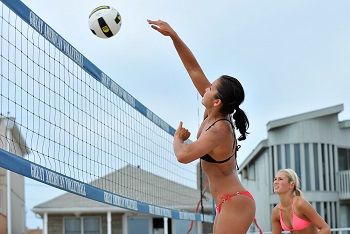Beach Volleyball Spike
Techniques for Spiking on the Beach
Beach volleyball spike techniques are somewhat different than spiking indoors.
Spiking in Sand Volleyball
Spiking in the sand isn't an easy task. With indoor volleyball, it's easy to talk about the 4 step or 3 step
volleyball spike approach.
However, when approaching to hit on the beach, your approach requires
different amounts of steps to get in position to jump and hit.
Tips for Spiking
As soon as you pass, start toward the net using as few steps as
possible. You want to take long strides, not short choppy steps.
Your last stride (big right followed
by a small left) in your approach should be a long powerful one. In the sand,
you must jump straight up. This is different than indoor.
When playing indoor,
you can broad jump or drift toward the net when you jump to hit. In the sand,
you'll likely get stuck and not get out of it very well if you don't jump straight
up.
Spiking at the Net
Volleyball Spike Techniques for Beach Volleyball
The three basic elements of the beach volleyball spike are the approach, the jump, and the contact.
Approach jump on the beach
The purpose of the approach is to turn your horizontal speed into vertical
power.
The approach on the beach is different than indoor because your approach
may require you to take many steps. For example, when playing indoor,
you likely will concentrate on perfecting a 3 or 4 step approach. On the
beach, you take as many steps as necessary to get to the place where
you need to jump and hit.
If you pass the ball from the endline, you have 30 feet to travel to hit
the ball. On the other hand, a short serve may require you to take
just 2 steps. So the last thing you should be
concerned about when approaching on the beach is counting your steps.
Hitting Around the Blocker
Approach quickly and explosively
After you pass the ball, quickly start moving towards the net. Move
quickly taking as few steps as possible. When you're about 4 or 5 feet
from your take-off
point, take one final powerful stride.
Step left-right-left if you're right-handed
If you're right-handed, take the big stride with the right leg and close
with the left as you plant to jump. A good approach allows you to
align your body into the optimal hitting position.
The beach
volleyball spike for right-handed hitters that hit on the left side
of the court, start your approach facing the direction that gives you
the best angle for your spike.
By facing the angle (cross court), you can hit the hard angle straight
on and still have the option of turning your torso hard to the left to
hit the ball down the line.
The beach volleyball spike for a right-handed player playing the right
side is a
little different. Approach the net facing down the line so you can hit
hard straight away and also give yourself the option to turn your torso
to the left to hit the ball angle.
If you're left-handed, reverse these techniques.
Explode Up as Fast as Possible
Plant both feet before you jump
After the last stride, your trailing leg comes forward to close the
approach as you plant both feet together to jump. You should be swinging
your
arms back as you plant. Then bring arms forward in a pendulum motion as
you lift off the ground.
Explode upward as fast as you can
With knees bent, explode upward as hard as you can. Look up at the ball as you throw your arms upward.
Don't broad jump
Since you're jumping in soft sand, you shouldn't be broad jumping. It's
important you jump straight up out of the sand. Jump straight up behind
the ball
while keeping it slightly in front of your body. Contact should be made
about 6 inches in front of your body.
You want to jump more straight up if you're playing in deep sand. Deep
sand can
make it difficult for you to get up high, so jumping more up than
forward will
help you get higher in the air for spiking.
Arm swing
Draw your hitting arm behind your head before you take a swing at the
ball. Be sure to extend your arm upward to contact the ball as high as
you can.
Get Up High and Outreach the Block
Beach Volleyball Spike Tips
Put topspin on the ball
It's very important to put topspin
on the ball. Make contact on top of the ball with your palm and put
topspin on the ball to drive it down into the court. Good topspin will
help you hit the ball down into the court instead of spraying the ball
out of bounds.
Develop an array of shots
To be successful in doubles, you need to develop an array of beach volleyball
spike techniques called "shots". The key to having an effective soft shot is to disguise it until the very last
moment.
Volleyball approaches in the sand that are explosive, with the
hitter contacting the ball at max height every time, aren't as easy for
the opponent to read.
When preparing for a beach volleyball spike, you should look like you're
going to hit the ball hard every time. By approaching hard every time,
you'll always have the option to swing hard or shoot the ball,
hitting a tough shot at the last second.

